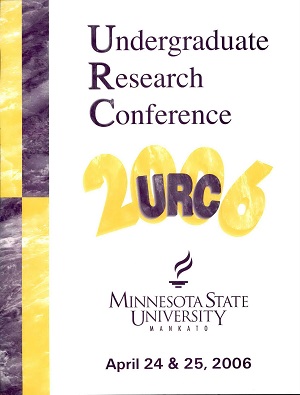Arabic Calligraphy in Modern Islamic Art and Its Ties to the Past
Location
CSU 284
Start Date
24-4-2006 10:30 AM
End Date
24-4-2006 12:30 PM
Student's Major
Art
Student's College
Arts and Humanities
Mentor's Name
Alisa Eimen
Mentor's Department
Art
Mentor's College
Arts and Humanities
Description
Calligraphy, an art form that has been rooted to the very beginnings of Islam, started with the copying of the holy book, the Qur'an. My studies revolved around how text has evolved and been integrated into the modern Islamic art world, from its roots in the seventh century through today. Since the events of September 11th, 2001, radical factions of Islam have captured media attention and the imagination of the public. This project was aimed at offering another view from an art historical perspective. I have analyzed the work of artists from Islamic countries alongside several working in the United States. Some artists that I have studied include Siah Armajani, Jamil Hamoudi and Hossein Zenderoudi. In the nineteenth century the colonization of the Islamic world took place, occurring over several decades. Alongside colonization, an interest from westerners of things foreign, exotic, and from the east arose, which in turn, had a profound effect on the creation process of Islamic art. I discovered a desire by artists to relate to one common and still relevant art form. Calligraphy offered a uniquely enduring art form that modem artists have creatively integrated into painting and sculpture. The purpose of this project was to add to the already existing information available on modem Islamic art, a field that has been understudied in the discipline of art history.
Arabic Calligraphy in Modern Islamic Art and Its Ties to the Past
CSU 284
Calligraphy, an art form that has been rooted to the very beginnings of Islam, started with the copying of the holy book, the Qur'an. My studies revolved around how text has evolved and been integrated into the modern Islamic art world, from its roots in the seventh century through today. Since the events of September 11th, 2001, radical factions of Islam have captured media attention and the imagination of the public. This project was aimed at offering another view from an art historical perspective. I have analyzed the work of artists from Islamic countries alongside several working in the United States. Some artists that I have studied include Siah Armajani, Jamil Hamoudi and Hossein Zenderoudi. In the nineteenth century the colonization of the Islamic world took place, occurring over several decades. Alongside colonization, an interest from westerners of things foreign, exotic, and from the east arose, which in turn, had a profound effect on the creation process of Islamic art. I discovered a desire by artists to relate to one common and still relevant art form. Calligraphy offered a uniquely enduring art form that modem artists have creatively integrated into painting and sculpture. The purpose of this project was to add to the already existing information available on modem Islamic art, a field that has been understudied in the discipline of art history.
Recommended Citation
Griesenbrock, Jana. "Arabic Calligraphy in Modern Islamic Art and Its Ties to the Past." Undergraduate Research Symposium, Mankato, MN, April 24, 2006.
https://cornerstone.lib.mnsu.edu/urs/2006/oral-session-C/1



